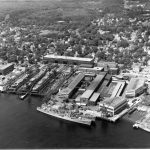After building a variety of experimental ships in the immediate post-WWII years, BIW won several contracts for larger groups of ships in the early 1950s. In an era of tight budgets, the Navy ordered relatively simple, low-cost ships that could be quickly mass-produced if another large-scale war broke out.
The first contract was for five Terrebone Parish-class tank landing ships, ordered in 1951 and delivered in 1952-53. These ships, known as LSTs or informally as “Large Slow Targets” by their crews, were designed to be beached on an enemy coast, allowing them to unload tanks, trucks, and troops directly onto the shore. The lead ship of the class was notable as the first U.S. Navy vessel actually commissioned in Bath.
The LSTs were closely followed by three Dealey-class destroyer escorts. These ships were smaller, less expensive versions of destroyers, intended solely to hunt enemy submarines. In this role they were successors to a large fleet of WWII-era destroyer escorts, and predecessors to the Perry-class frigates built at BIW in the 1970s and 1980s.
The nine Forest Sherman-class destroyers, delivered in 1956-1959, closed out the era of traditional destroyers, armed primarily with guns and torpedoes. These ships more closely resembled the destroyers of WWII, but were outfitted with newer, rapid-fire guns. Recognizing the rapid advance of technology, the Navy later converted some of the Sherman-class ships to guided missile destroyers, and the entire class was retired in the early 1980s.
During this period BIW began a transition to subassembly- or unit-based construction, which has continued to this day. The centerpiece of the transition was a new Assembly Building (today known as the Shell Shop) across the top of the ways. The elevated crane-ways were extended to the front of the building, so an entire ship unit – weighting some 25 to 50 tons – could be lifted and carried directly out to the ways.
Although far from today’s ultra units, weighing thousands of tons, this marked a dramatic change from the stick-built practices common a decade earlier, and the first step toward today’s construction techniques.
There were other changes throughout the yard to upgrade outdated and war-worn facilities. Some of these projects included reconstruction of the north pier, an overhaul of the machine shop, construction of the north electric shop (now demolished), installation of new cranes and reconstruction of the blacksmith shop, which serves as the Trade Learning Center today. This modernization placed BIW in a solid position to win contracts for guided missile warships as the Navy moved forward into the missile era.



